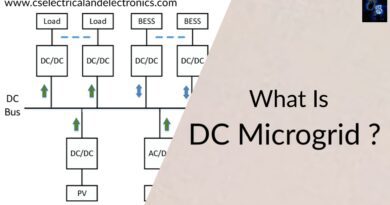Types Of House Wiring, Advantages And Disadvantages
Hello everyone, in this article, I will discuss interior wiring, types of house wiring, advantages, and disadvantages of various types of wiring systems.
If you want an article on some other topics then comment us below in the comment box. You can also catch me @ Instagram – Chetan Shidling
Also, read:
Types Of House Wiring
House Wiring
Interior electrical wiring is commonly known as an electrical installation for operation by end users within a building. It includes the cabling and associated devices such as switches, sockets, distribution boards, and light fittings. Such wiring is subject to rigorous safety standards for design and installation with restrictions on the environmental conditions such as ambient temperature range moisture level exposure to sunlight and chemicals.
Types of House Wiring
Following are the common types of interior wiring such as :
- Cleat wiring
- Batten wiring
- Casing capping wiring
- Conduit Wiring
1. Cleat Wiring

This type of wiring VIR or PVC insulated wires (occasionally sheathed and weatherproof cable) are drawn in the grooves of porcelain plastic or wood cleat which is fixed by screws.
The distance between cleat is to be about 60 cm. The wiring cost is cheap, it is a temporary wiring system, therefore, it is not suitable for domestic premises. The use of a cleat wiring system vanishes nowadays.
Advantages of Cleat Wiring
- It is a simple and cheap wiring system.
- Most suitable for temporary use I.e., under construction of a building or army camping.
- As the wires of cleat wiring are open air. Therefore fault in wires can be seen and repair is easy.
- Installation is easy and simple.
- Alternation and addition can be done easily in this wiring.
Disadvantages of Cleat wiring
- Appearance is not good.
- It can be used only on 250/400 volts at low temperatures.
- It is not a sustainable wiring system.
- Insulation may deteriorate after some time because the weather affects the risk of fire and wear and tear.
- It is a temporary wiring system that can’t be used for permanent wiring.
2. C.T.S / T.R.S wiring

In this wiring cab tires sheathed (C.T.S) or tough rubber sheathed (T.R.S) cables of single or double or three core are used. The cables are run on well seasoned and straight teak wood batten with at least a thickness of 10mm.
The cables are fixed on the wooden batten by means of tinned brass link clips of suitable size and spaced at an interval of 10 cm for horizontal runs and 15 cm for vertical runs.
Advantages of Batten wiring
- (a). It is simple easy and cheap compared to a Conduit wiring system.
- (b). The appearance is good and beautiful.
- (c). Strong and long-lasting.
- (d). Less chance of leakage current.
- (e). Repairing and customization i.e., alternation and addition can be done easily.
Disadvantages of Batten wiring
- (a). Can’t be used in the humidities, chemical effect open and outdoor areas.
- (b). High risk of fires.
- (c). Not safe from external wear and tear and weather effects.
- (d). Only suitable below 250V.
- (e). Need more wires.
3. Casing and Capping wiring

The cable used in this kind of wiring was either VIR or PVC or any other approved cables. The cables were carried through the wooden casing and enclosures. The casing is made up of a strip of wood with parallel double or triple grooves cut lengthwise so as to accommodate the cable.
The capping also made of wood used to cover the wires installed and fitted in the casing. Nowadays teak wood is replaced by P.V.C for casing and capping system which are having a good appearance. This wiring system is particularly used for all additional wiring which was not done during the construction period.
Advantages of casing capping
- It is cheap compared to the conduit system.
- It is strong and long-lasting and can be customized easily.
- Installation rewiring and repair is easy and economic.
- As cables are running in separate slots short-circuiting chances are less.
- It gives a good and beautiful appearance.
Disadvantages of casing and capping
- There is a high risk of fire in this wiring system.
- It is not suitable in the damp and wet areas.
- White ants may damage the wood casing and capping.
- Highly skilled work is required.
4. Conduit wiring system

There are two types of conduit wiring.
- (a) Surface Conduit Wiring system
- (b) Concealed Conduit Wiring system
(a). Surface Conduit Wiring System
If conduits installed on the wall, it is known as surface conduit wiring. In this wiring method conduit pipes are fixed on walls and roof with the help of heavy gauge saddles at an interval of 1 M. along with conduit accessories like bends, elbows, junction boxes, etc., this system is used in heating circuit wiring and all other power wirings such as a workshop, industrial and palimpsest wiring, etc., and also in lighting wiring of the existing building.
(b). Concealed conduit wiring system :
If the conduit is hidden inside the wall slots with the help of plastering it is called concealed conduit wiring. In another way, the electrical wiring system inside the wall, roof with the help of plastic or metallic piping is called concealed conduit wiring. Obviously, it is the most popular, beautiful, strong, and common Electrical wiring system nowadays.
Types of Conduit
Mainly there are three types of conduit :
(a) Screwed conduit: These conduits are also known as a rigid metal conduit (RMC). They are used to the underground system. To give a good degree of mechanical protection from moisture, the conduits are solid drawn or welded with steam pipes.
(b) Split Conduit: This type of conduit is threadable the pipe joint is by means of couplings and it is used in surface conduit wiring. It is also made of steel with a protective coating like a screwed conduit. However, it is suitable for surface conduit only.
(c) Flexible conduit: In the case of metallic conduit flexible conduit is made of helically wound, formed, interlocked metal strip. This type of conduit is used where the flexibility of pipe is required as in the case of carrying wire from starter to motor. Nowadays metal conduits are replaced by P.V.C flexible conduit.
Advantages of Conduit Wiring systems
- No risk of mechanical wear and tear and fire, hence it is the safest wiring system.
- Customization can be done easily.
- Repairing and maintenance are easy.
- It is a long-lasting reliable and popular wiring system.
- It can be used even in the humidity chemical effect and risk of fire.
Disadvantages of conduit wiring system
- It is an expensive wiring system.
- Installation is difficult and complicated wiring.
- Very difficult to locate and rectify the faults.
- Very complicated because if we want to connect additional things in the future.
I hope this article may help you all a lot. Thank you for reading. If you have any doubts on types of house wiring, then comment below.
Tag: Types Of House Wiring
Also, read:
- 10 Tips To Maintain Battery For Long Life, Battery Maintainance
- 10 Tips To Save Electricity Bills, Save Money By Saving Electricity
- 100 (AI) Artificial Intelligence Applications In The Automotive Industry
- 100 + Electrical Engineering Projects For Students, Engineers
- 1000+ Control System Quiz, Top MCQ On Control System
- 1000+ Electrical Machines Quiz, Top MCQs On Electrical Machines
- 1000+ MATLAB Simulink Projects For MTech, Engineering Students
- 50 Tips To Save Electricity At Home, Shop, Industry, Office
- 50+ Question And Answer On The Substation, Electrical Question
- 500+ Matlab Simulink Projects Ideas For Engineers, MTech, Diploma
- 500+ Projects For Diploma Electrical, Electronics Student, Diploma Project
- Active Cell Balancing Using A Flyback Converter Simulation In Matlab Simulink
- AI Artificial Intelligence Applications In Electric Vehicles | Future?
- AI Tools For Electronic Circuit Design, Which Is Best?
- Applications Of Artificial Intelligence (AI) In Renewable Energy
- Automotive Industry Or VLSI Chip Industry ? Which Is Best?
- Basic Electrical Engineering, Terms, Definitions, SI Unit, Formula
- Basic Electrical Quiz, Take Online Test On Basic Electrical, Electrical Quiz
- Battery C Rate Online Calculator With Time Calculation
- Battery Management Systems In Electric Vehicles, BMS Operations
Author Profile
- Chetu
- Interest's ~ Engineering | Entrepreneurship | Politics | History | Travelling | Content Writing | Technology | Cooking
Latest entries
 All PostsApril 19, 2024What Is Vector CANoe Tool, Why It Is Used In The Automotive Industry
All PostsApril 19, 2024What Is Vector CANoe Tool, Why It Is Used In The Automotive Industry All PostsApril 13, 2024What Is TCM, Transmission Control Module, Working, Purpose,
All PostsApril 13, 2024What Is TCM, Transmission Control Module, Working, Purpose, All PostsApril 12, 2024Top 100 HiL hardware in loop Interview Questions With Answers For Engineers
All PostsApril 12, 2024Top 100 HiL hardware in loop Interview Questions With Answers For Engineers All PostsMarch 22, 2024Driver Monitoring Systems In Vehicles, Working, Driver Sleepy Alert
All PostsMarch 22, 2024Driver Monitoring Systems In Vehicles, Working, Driver Sleepy Alert








